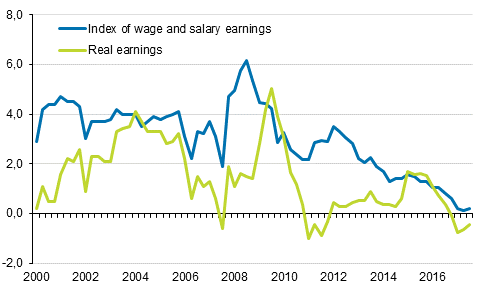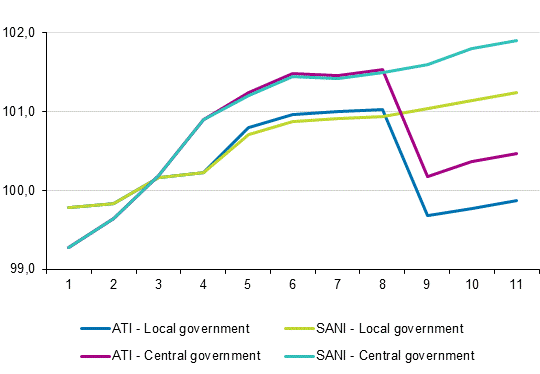Published: 12 October 2017
Wage and salary earners' earnings rose by 0,2 percent
According to Statistics Finland’s preliminary data, the nominal earnings of wage and salary earners rose by 0.2 per cent on average in July to September 2017 when compared to the respective period in 2016. In the private sector, nominal earnings rose by 0.6 percent. As for the central government sector and the local government sector, the nominal earnings of wage and salary earners decreased by 1.0 and 1.1 percent respectively. Real earnings fell by 0,4 1) per cent on average compared to the third quarter of the previous year.
Year-on-year changes in index of wage and salary earnings 2000/1–2017/3, per cent

Competitiveness Pact visible in public sector earnings development
The cut in holiday bonuses agreed on in the Competitiveness Pact has been taken into account in the index of wage and salary earnings and it has a negative effect on the development of the index of wage and salary earnings in the central and local government sectors starting from the first quarter of 2017. According to Statistics Finland’s preliminary data, wage and salary earners’ nominal earnings rose in the private sector by 0.6 per cent from July to September 2016 to the corresponding period in 2017. In the central and local government sectors, nominal earnings fell, in the central government sector by 1.0 per cent and in the local government sector by 1.1 per cent.
Wage and salary earners’ regular earnings increased by 0.5 per cent in July to September
Regular earnings rose by 0.5 per cent in July to September 2017 when compared with the respective period in 2016. They grew by 0.6 per cent in the private sector, by 0.5 per cent in the central government sector and by 0.3 per cent in local government.
The index for regular earnings describes the earning development better than the index of wage and salary earnings because it does not take into account performance-based bonuses and non-recurring items included in collective agreements. The cuts in holiday bonuses agreed on in the Competitiveness Pact are not taken into consideration in the index for regular earnings.
The figure below examines the development of the index of wage and salary earnings and the index of regular earnings in 2015 to 2017. The public sector was selected to the examination and it ends in the last published quarter, that is, the third quarter of 2017. The cut in the public sector holiday bonuses is visible in the development of index of wage and salary earnings in the central and local government sectors. For both, the index of wage and salary earnings falls in the first quarter of 2017. A corresponding fall does not occur in the development of the index of regular earnings.
Development of the index of wage and salary earnings (ATI) and the index of regular earnings (SANI) 2015=100 in 2015 to 2017

Index of wage and salary earnings and index of regular earnings are final as far as the year 2016
The indices are final as far as the year 2016 and they are based on final wage statistics. The indices for 2017 are still preliminary. They are based on the effects of agreements and the wage drift. In addition, the data on performance-based bonuses of the Labour Cost Index are used to assess performance-based bonuses in the calculation of the preliminary indices of the index of wage and salary earnings.
1) Preliminary data. The year-on-year change in consumer prices for September 2017 is published on 13 October 2017. The change in real earnings in the 3rd quarter is based on the change in consumer prices only for July and August 2017.
Source: Index of wage and salary earnings 2017, 3rd quarter. Statistics Finland
Inquiries: Anu Uuttu 029 551 2322, Harri Nummila 029 551 3235, palkat.indeksit@stat.fi
Director in charge: Sami Saarikivi
Publication in pdf-format (452.5 kB)
- Tables
-
Tables in databases
Pick the data you need into tables, view the data as graphs, or download the data for your use.
Appendix tables
- Appendix table 1. Index of wage and salary earnings 2015=100 by employer sector and base of payment (12.10.2017)
- Appendix table 2. Index of regular earnings 2015=100 by employer sector and base of payment (12.10.2017)
- Appendix table 3. Index of wage and salary earnings 2015=100 by employer sector and gender (12.10.2017)
- Appendix table 4. Index of regular earnings 2015=100 by employer sector and gender (12.10.2017)
- Appendix table 5. Index of wage and salary earnings 2015=100 by industry, (TOL 2008) (12.10.2017)
- Appendix table 6. Index of regular earnings 2015=100 by industry, (TOL 2008) (12.10.2017)
- Appendix table 7. Index of wage and salary earnings 2010=100 by employer sector and gender (12.10.2017)
- Appendix table 8. Index of wage and salary earnings 2010=100 by industry, (TOL 2008) (12.10.2017)
- Appendix table 9. Index of wage and salary earnings 2015=100, percentage changes (12.10.2017)
- Appendix table 10. Index of regular earnings 2015=100, percentage changes (12.10.2017)
- Appendix table 11. Average earnings by employer sector and gender, EUR/month (12.10.2017)
- Revisions in these statistics
-
- Revisions in these statistics (12.10.2017)
Updated 12.10.2017
Official Statistics of Finland (OSF):
Index of wage and salary earnings [e-publication].
ISSN=1798-7814. 3rd quarter 2017. Helsinki: Statistics Finland [referred: 18.12.2025].
Access method: http://stat.fi/til/ati/2017/03/ati_2017_03_2017-10-12_tie_001_en.html

